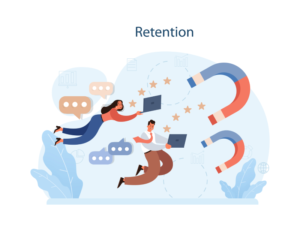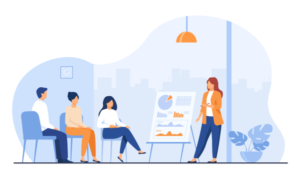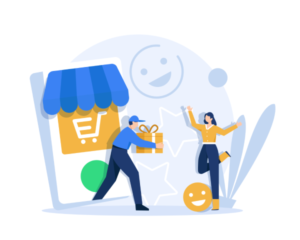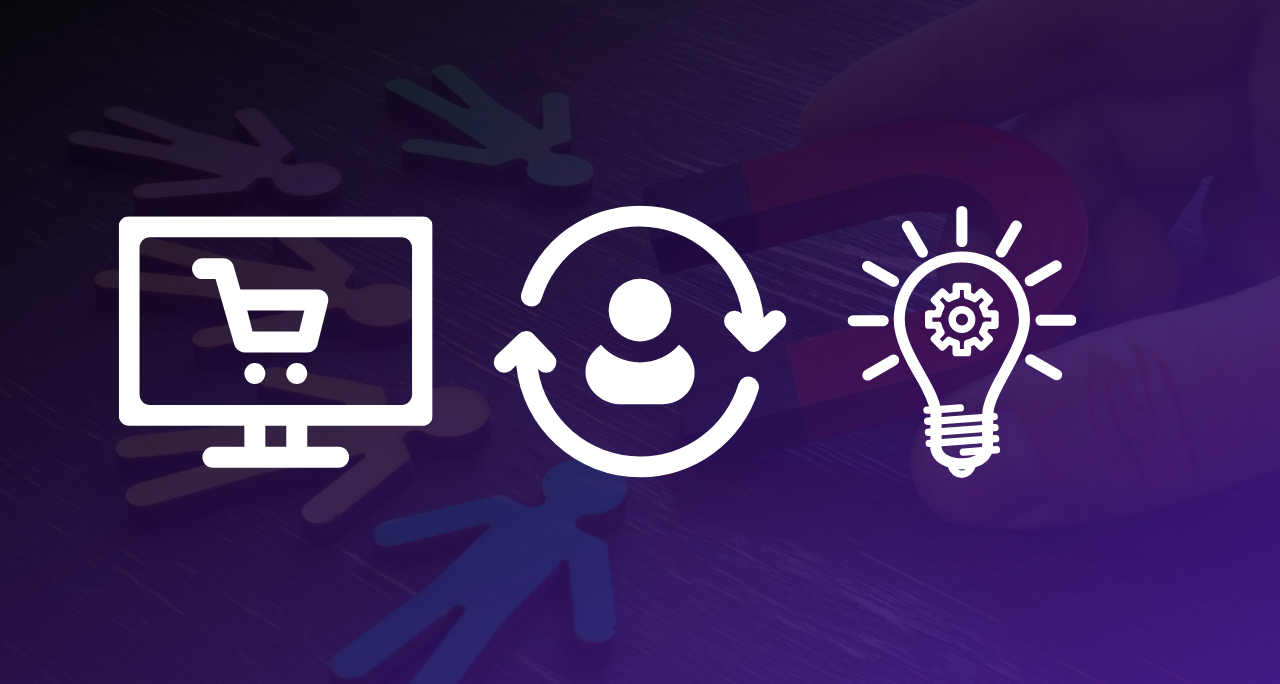In the dynamic realm of eCommerce, customer retention isn’t just a strategy—it’s a game-changer. As the competition heats up and consumer choices multiply, the power of keeping your existing customers engaged cannot be underestimated.
This article delves into the art of tailor-made retention strategies, strategically aligned with the multifaceted stages of the customer funnel. By recognizing the dynamic nature of customer journeys, we unveil a comprehensive approach to nurturing brand loyalty and engagement.

As we navigate through each distinct phase, from initial awareness to long-term advocacy, this piece seeks to equip businesses with actionable insights that empower them to conquer retention challenges and thrive in the dynamic world of eCommerce.
Early Stage
Did you know that new users are the most likely to churn among all your customers?
The early stage of the customer funnel is akin to the first light of dawn—the moment when potential customers first become aware of your brand’s existence. At this stage, curiosity is piqued, and the journey of discovery begins.
To minimize early-stage churn, focus on capturing attention, evoking interest, and setting the foundation for a lasting relationship.
Here, crafting effective retention strategies involves a delicate blend of art and strategy:
Introduce a Trial Option with Peace of Mind
Provide potential customers the opportunity to explore your product through a free trial or a freemium version, ensuring they can engage without any concerns. This way, prospects can confidently assess your offering, making informed decisions and minimizing the likelihood of churn from users who may not align with your product’s value.
Craft On-Demand Customer Training Resources

Create user-friendly and informative training materials that empower customers to master your product. By grasping the key requirements of your new customers, you can deliver tailored onboarding journeys and provide dedicated assistance that aligns seamlessly with their unique needs.
Forge Personal Bonds with New Users
Cultivate a robust marketing approach that forges connections with fresh clientele, fostering immediate brand trust. Initiate this rapport by sending tailored welcome emails and nurturing these relationships with expert tips and guidance to kick-start their journey.
Craft a Stellar Onboarding Journey
The success of your onboarding process can sway a new user’s decision to either embrace your product or disengage within days. Foster a frictionless onboarding experience by harnessing the power of in-app guidance.
Elevate your product’s allure with interactive walkthroughs, informative tooltips, and handy checklists. This strategic approach not only mitigates early-stage churn but also alleviates the demands on your customer support team.
In essence, the early stage is about leaving a memorable impression, igniting the desire to learn more, and setting the tone for a journey that will unfold across the various stages of the funnel. As you navigate this stage, keep in mind that your goal is to captivate attention and initiate a connection that will evolve into a meaningful relationship.
Mid-Term Stage
The mid-term stage of the customer funnel represents the phase where initial interest has bloomed into genuine consideration and evaluation. There is always a risk that the customer will be lured towards more competitive competitor offerings or products. This is the time to nurture their interest and provide the information they need to make an informed decision.
Supporting customers throughout their journey is crucial for reducing mid-term churn. By ensuring their satisfaction during this stage, you can increase the likelihood that they will remain loyal long-term.
In this stage, the strategies focus on guiding and empowering prospects:
Swiftly Detect and Resolve UI Concerns
Monitor user feedback and analytics to detect any UI issues causing frustration or confusion. Address these issues quickly to improve the user experience and prevent churn. Adopt the following best practices:
- Collect data on user interactions with your product using heatmaps and user surveys.
- Always perform A/B tests to validate potential solutions before implementing them.
- Keep an eye on user feedback and analytics so you can quickly fix any problems that come up.
Improve your customer service

Build long-term customer relationships and reduce the likelihood of churn by implementing the following tips for a positive customer service experience:
- Offer omnichannel support: email, chat, social media, and phone, or outsource.
- Use customer service software that helps to track ticket requests.
- Prioritize prompt response times.
- Consider using a chatbot that can answer frequently asked questions to reduce the load on your support team. Chatbots are great at improving efficiency and increasing customer satisfaction.
Implement an Integrated CRM System
A common misconception about CRM systems is that they’re solely for lead generation and closing deals. However, they can also serve as a potent tool for retaining customers. By making your CRM system a central hub for data, you enable sales, marketing, and customer success teams to collaborate effectively and stay well-informed about your customers.
Furthermore, past interactions logged in the CRM can serve as valuable historical records.
- Review previous conversations to identify what resonated most with customers.
- Analyze what personalization tactics were successful and what didn’t quite hit the mark.
- Keeping a record of these insights will prove invaluable for future communications.
When you tailor your conversations based on individual preferences, customers will perceive a more human touch in your interactions. This not only fosters customer appreciation but also lays the foundation for building strong relationships, a critical factor in customer retention.
Long-Term Stage
Your long-term customers are invaluable, and while they’re less likely to leave, losing them would cancel out all the effort you put into keeping them. Always strive to keep them satisfied.
Here are some ways to help you do that:
Collect customer feedback and act on it
Continuously gather product feedback to uncover areas for improvement. In addition to scrutinizing visual product data, it’s crucial to heed the voice of your customers (VoC). Conduct customer surveys and interviews to gain deeper insights beyond the quantitative data.
An excellent tool for this purpose is Survicate. It enables you to design micro-surveys that solicit user feedback on their experiences with your product during their interactions with it. What makes it even more valuable is its seamless integration with Smartlook, which allows you to correlate real user sessions with the feedback received.
Reward loyal customers

Last but not least, show appreciation to your most devoted customers by providing them with special offers and exclusive opportunities to ensure their continued loyalty. These customers have remained loyal to your company over an extended period and have significantly contributed to your Annual Recurring Revenue (ARR). Recognize their loyalty by extending exclusive benefits that set them apart from lower-tier or new customers.
Strengthen relationships and reduce churn by offering rewards or incentives to long-term customers. Some practical ways to do this include:
- Loyalty programs: Provide discounts, free products, or exclusive access to new features for long-term customers.
- Referral programs: Urge loyal customers to refer friends and family by offering rewards, discounts, or cash bonuses.
- Surprise them: Offer unexpected rewards or gifts, such as personalized thank-you notes or free merchandise.
Develop a Customer Win-Back Strategy
Rekindling a relationship with a former customer is often easier than acquiring a new one.
- Initial Outreach: Start by reaching out to these former customers.
- Identify Dissatisfaction Reasons: Determine why they were dissatisfied with your product or why they discontinued its usage.
- Payment Issues: Sometimes, the issue may be as simple as a failed credit card payment. In cases of payment failures, proactively contact the customer and encourage them to update their payment information.
If you notice recurring payment issues, consider implementing a more robust dunning process. The dunning process involves requesting payment from customers who owe the company money and is an effective way to uncover the reasons behind non-payment.
However, there are situations where customers deliberately left your product. It could be due to budget constraints within their organization. In such instances, explore options to accommodate their circumstances. The most successful approach to winning back lost customers revolves around open communication, flexibility, and conveying your commitment to helping them achieve success with your service.
Conclusion
In the fast-paced and ever-evolving world of e-commerce, the importance of customer retention cannot be overstated. It’s not just a strategy; it’s a transformative force that can make or break a business. As competition continues to intensify and consumers are presented with an ever-expanding array of choices, the ability to engage and retain your existing customers emerges as a crucial factor in your company’s success.
Therefore, customer retention isn’t a one-size-fits-all approach; it’s a journey with different stages, each demanding a unique set of strategies. By implementing retention tactics tailored to your customers’ needs, you’ll not only reduce churn but also foster stronger, more lasting relationships that drive your e-commerce business forward.
Embrace the dynamic nature of customer journeys, adapt your strategies, and watch your brand not only survive but thrive in the competitive landscape. Remember, it’s not just about retaining customers; it’s about building lasting partnerships that propel your business to new heights in the digital marketplace.





